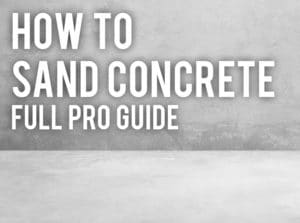As an Amazon Associate I earn from qualifying purchases. All claims are strictly my personal opinion.

It’s widely used, extremely versatile and it can be found in nearly every house – be it inside or out. With time it can get cracked, stained or damaged in a number of other ways and the best way to repair it is by sanding, although it takes a few different tricks to do it perfectly.
Sanding your concrete surfaces is very important since it’s crucial to maintaining and repairing them in both looks and structural integrity. As mentioned above, it can be a bit tricky for beginners so I’ll be guiding you through all the steps to ensure that you ace it – without further ado, let’s take a look at how to sand concrete like a pro!
How to Sand Concrete in 5 Steps
Follow these steps closely to ensure that you achieve a perfect result!
1 – Check the Type of Damage
There are different damages that might have occurred on your concrete and before you try sanding those cracks or holes in your concrete porch, or other structure, you have to prepare for the repairs.
If the concrete you’re checking is part of a driveway, a tabletop or any other non-structural piece, you can move forward with the DIY repairs with confidence but if the cement is a crucial part of your house’s structural integrity – walls, pillars, among others – then you’d better check the damage carefully.
If it looks serious, I recommend hiring the services of a professional inspector to carry out an inspection on the type of damage. At times, damages reveal to be more serious problems and patching might not maintain the strength of the concrete, leading to unsafe results. That is why the advice of the inspector is essential.
After this is done, it’s time to get all the items you need.
2 – Get the Necessary Equipment
Before you actually start the process of sanding your concrete you should get the right pieces of equipment. Some of the equipment you might need include an electric sander, coarse grit sandpaper, fine grit sandpaper, and superfine grit sandpaper as well. Other recommended items include a dust mask, eye protection and some ear muffs too to ensure your comfort and safety.
Choosing the perfect machine can be daunting if you’re new but don’t worry – I’ve already done all the hard work of testing them out for you. This is my top recommendation for sanding concrete:
Bosch 1250DEVS 6.5 Amp Corded 6 in. Variable Speed Dual-Mode Electronic Random Orbital Sander/Polisher

Vicious power
Aggressive turbo-mode
Tank-like durability and strength
If you want to see more options and learn more about the top machines for this type of work, be sure to read the “best sanders for walls” article. You can also take a look at the random orbital sanders or the sheet sanders. Both of them are excellent types for concrete.
After getting your machine, you’ve gotta choose sandpaper that fits it (discs, sheets, belts, etc…). As you’ll need to do multiple sanding passes, each with an increasingly finer result, be sure to get a few different grits of sandpaper as well – from the coarser 50 grit to the finer 120 to 240 and even more (1000) if you want a truly high-polish result. You should also consider purchasing plastic and tape sheets that can be used to cover any walls, cabinets, and fixtures to protect them from damage, dust and debris. Other important supplies you need, as mentioned previously, are goggles and dust masks since the concrete dust can damage your health.
3 – Prepare the Working Site
Once you have realized how damaged your concrete is and after gathering all the necessary equipment, it’s now time to prepare the area surrounding the work zone. For instance, if there is any furniture you should remove it from the room, then clean the floor so that you can remove any present debris.
If the repair is being done on the inside of the room then you should set up a plastic sheet to protect the walls and any cabinetry. This is will protect your beautiful furniture from getting all dirty which will save you tons of work and make clean-up a breeze.
4 – Thoroughly Sand the Concrete
After you have prepared the area, it’s time to choose your sandpaper. The sandpaper you choose depends on the quality and intensity of sanding you want to do.
Normally, you’d start by using a coarse grit sandpaper that is in the range of 40-60 grit. This type of sandpaper is meant for basic sanding and stripping purposes. If you want smooth finishes then the perfect sandpaper is of 80-120 while the smoothest finish requires a grit of 200-400 and above.
Regardless of how smooth you want the final result to be, always start with the lowest grit you have available and then slowly move up the ladder to finer grits with each sanding pass you perform.
If you’re using wet sandpaper, you should also wet the concrete you are working on so as to keep the dust down. You shouldn’t let the slurry dry out because the concrete will become hardened again so be sure to remove it regularly.
5 – Smooth the Concrete
After you have finished all the other steps it’s time to give your concrete a new and fresh look. You can make it smooth by using the second finest sandpaper you have, putting your sander on the highest speed setting and then beginning from one corner of your concrete surface and finishing on the other. You should do this in lengthwise and width-wise directions.
Afterwards you simply clear the area of any dust then go over the floor with a superfine sandpaper (the finest you have available). You can then inspect the concrete floor and make sure everything looks perfect. Finally, gently mop the whole area and then let it dry naturally.
And just like that, you’re done! Enjoy your beautifully repaired concrete surface.
By reading and following these 5 simple steps, you’ll not only know how to sand concrete like an expert but you’ll also be able to get the right results everytime!
Thanks as always for reading and I’ll see you on the next one.


What are your suggestions for stripping concrete finishes off concrete. The finishes have a look of cracked plastic on top color of white. Really takes away from the beauty of the concrete.